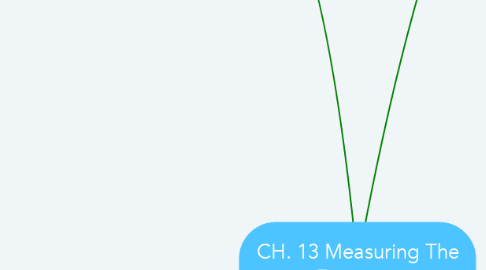
1. 13.2 -- How do Economist measure the size of an economy?
1.1. Gross Domestic product(GDP) is the main way to measure the total country's economic output. It is a big part of the way economist measure the size of an economy and is much needed.
1.1.1. gross domestic product [gross domestic product: the market value of all final goods and services produced within a country during a given period of time]
1.1.2. value [market value: the price buyers are willing to pay for a good or service in a competitive market]
1.2. Economist Calculate GDP by measuring expenditures on goods and serveses produced in a country. There are four sectors of the economy. Households, businesses, government and foreign trade. These four sectors are broken down by each sectors spending. Including household consumption, buisness investment, goverment purchases and the net of exports minus imports. Overall all Economist typically use this formula to calculate GDP.
1.2.1. net exports [net exports: the value of all exports minus all imports]
1.2.2. [nominal GDP: a measure of a country’s economic output (GDP) valued in current dollars; nominal GDP does not reflect the effects of inflation]
1.3. Scientist also use the calculations in GDP figures to see if a country's GDP is ether growing or shrinking. However dtermining a country's GDP is not simple due to inflation which drives the prices of goods and services overtime.
1.3.1. [per capita GDP: a nation’s real GDP divided by its population; a measure of average economic output per person]
1.4. GDP growth makes people better off by effecting literacy and education, Health and life expectancy and the standerd of living in a positive way. with everything from higher scores and smarter kids and good health and medical advisers.
2. 13.3 -- What Does the Unemployment Rate Tell Us About an Economy’s Health?
2.1. unemployment rate [unemployment rate: the percentage of the labor force that is not employed but is actively seeking work]
2.2. the Government Measures Unemployment Every month, the BLS reports the total number of people who were unemployed for the previous month. Also Members of the labor force who have jobs are classified as employed. and Members of the labor force who are jobless, but are looking for work, are classified as unemployed.
2.3. The four types of Unemployment In its interviews, the BLS gathers detailed information about people who are unemployed. Based on those data and further research, economists identify four types of unemployment: frictional, structural, seasonal, and cyclical.
2.4. Frictional unemployment is when a person has left one job and is looking for another, is what economists call frictional unemployment.
2.4.1. t [frictional unemployment: a type of unemployment that results when workers are seeking their first job or have left one job and are seeking another] .
2.5. Structural unemployment, is people who choose to change jobs are in transition. Their skills are still in demand and the time they spend without a job is usually short. The same cannot be said of those who experience structural unemployment.
2.5.1. . Structural unemployment [structural unemployment: a type of unemployment that results when the demand for certain skills declines, often because of changes in technology or increased foreign competition; under such conditions, workers may need retraining to find new jobs]
3. 13.4--What Does the Inflation Rate Reveal About an Economy’s Health?
3.1. The BLS tracks inflation by gathering information on Americans' cost of living in an effort to see and calculate Inflation with the Consumer Price Index
3.1.1. [consumer price index: (CPI)a measure of price changes in consumer goods and services over time
3.2. Creeping inflation. In the United States we have come to expect a certain amount of gradual inflation, or creeping inflation, every year.
3.2.1. [creeping inflation: a gradual, steady rise in the price of goods and services over time] ,
3.3. Hyperinflation. Occasionally inflation goes into overdrive. The result is hyperinflation. Runaway inflation creates extreme uncertainty in an economy. Nobody can predict how high prices will go, and people lose confidence in their currency as a store of value.
3.4. Deflation. The inflation rate is usually a positive number, meaning that the overall price level is rising. But the inflation rate can be negative, a condition that economists call deflation. Deflation occurs when prices go down over time.
4. 13.5--How Does the Business Cycle Relate to Economic Health?
4.1. Business cycles are irregular in both length and severity. This makes peaks and troughs difficult to predict. Nonetheless, economists attempt to do just that, using a variety of economic indicators.
4.1.1. trough: the lowest point of a contraction, or period of economic decline; a trough is followed by economic growth
4.2. Leading indicators, Measure the consistent rise or fall several months before an expansion or a contraction begins are called leading economic indicators.
4.3. Coincident economic indicators are measures that consistently rise or fall along with expansions or contractions.
4.4. Lagging indicators Measure thhe consistent rise or fall several months after an expansion or a contraction are known as lagging economic indicators.
4.4.1. contraction: a period of general economic decline marked by falling GDP and rising unemployment

